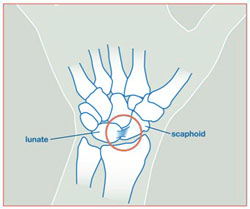 What is it?
What is it?
Injuries to ligaments are known as sprains. Ligaments are the tissues that connect and stabilize bones. Think of them like a strong tape that joins bones together where they meet at joints. Not all sprains are alike; there are three degrees of severity: Grade 1 – stable injury; Grade 2 – Partial tearing/stretching; and Grade 3 – Complete tear. Sprains disrupt healthy wrist coordination and typically result in stiffness, pain, swelling, and instability.
What causes it?
Wrist sprains occur when the wrist is met with excessive force. This often happens when a hand is used to catch oneself in a fall either backwards or forwards. Wrist sprains are also associated with sports and outdoor activities.
What are the symptoms?
Patients most commonly present with pain and stiffness in the wrist, as well as a loss of strength.
How do we diagnose it?
 In order to properly diagnose a wrist sprain, we must carefully analyze the patient’s history (including the details of how the injury occurred), conduct a physical exam and run diagnostic testing. When we examine the wrist, we’ll be able to locate the exact location of the injury. To assess possible fractures and check for ligament insufficiency, an x-ray is often used. Although we can’t actually see ligaments on x-rays, the signs of a ligament injury are visible. An MRI may also be used to obtain more information about the injury.
In order to properly diagnose a wrist sprain, we must carefully analyze the patient’s history (including the details of how the injury occurred), conduct a physical exam and run diagnostic testing. When we examine the wrist, we’ll be able to locate the exact location of the injury. To assess possible fractures and check for ligament insufficiency, an x-ray is often used. Although we can’t actually see ligaments on x-rays, the signs of a ligament injury are visible. An MRI may also be used to obtain more information about the injury.
How is it treated?
Wrist ligament treatments seek to relieve pain and stiffness, restore movement and stability, and lower the risk of long-term effects. The treatment is determined by the injury severity. Many wrist ligament injuries can be successfully treated with supportive splinting and temporary reduced activity until the ligaments have fully healed.
With more severe injuries, like ligament tears, surgery may or may not be employed. Wrist arthroscopy might be advised to learn more about the injury and possibly trim inflamed flaps away from the injured ligament. If the arthroscopy uncovers a more serious injury, we may decide to perform open ligament repair/reconstruction. Because the ligaments are so small, it is often necessary to add more tissue through the use of a graft.
Chronic Wrist Injuries
When a wrist injury goes unrecognized or untreated, the consequence may be wrist instability, which can lead to arthritis. Symptoms of arthritis are often treated by use of splints, modification of activity, and application of anti-inflammatory medications. Severe symptoms can sometimes be relieved with steroid injections. If the aforementioned treatments are not successful, we might consider surgery to take out the damaged joint surfaces.


